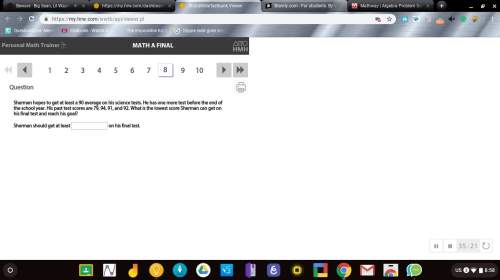
Mathematics, 16.03.2020 20:09 salinasroel22
Consider a population proportion p = 0.68. a-1. Calculate the expected value and the standard error of P− with n = 30. (Round "expected value" to 2 decimal places and "standard deviation" to 4 decimal places.) a-2. Is it appropriate to use the normal distribution approximation for P− ? Yes No b-1. Calculate the expected value and the standard error of P− with n = 40. (Round "expected value" to 2 decimal places and "standard deviation" to 4 decimal places.) b-2. Is it appropriate to use the normal distribution approximation for P− ?

Answers: 3


Other questions on the subject: Mathematics

Mathematics, 21.06.2019 14:30, jksike223
Ablock of wood is a cube whose side is x in. long. you cut off a 1-inch thick piece from the entire right side. then you cut off a 3-inch thick piece from the entire top of the remaining shape. the volume of the remaining block is 2,002 in3. what are the dimensions of the original block of wood?
Answers: 2

Mathematics, 21.06.2019 16:30, jessica01479
Scale factor of 2 is used to enlarge a figure as shown below the area of is 18 in.²
Answers: 3

Mathematics, 21.06.2019 16:50, lunamoon1
The rate of decay of a radioactive substance depends upon the amount present initially. the mass y (mg) of the radioactive substance cobalt-60 present in a sample at time t (years) is represented by the exponential equation y=50e −0.1315 t . answer the following questions in complete sentences. 1. how does the exponential equation above compare to the equation for simple interest that is compounded continuously? explain the similarities. 2. what is the initial amount of cobalt-60 in the sample? 2. how much cobalt-60 is left after 8.4 years? show your work. 3. what would be the y-intercept of the graph? what does it represent? 4. after how many years will the amount of cobalt-60 left be 6.25 mg? explain what happens to the cobalt-60 after 50 years? 5. discuss some “real-world” examples and uses of cobalt-60
Answers: 1

Mathematics, 21.06.2019 20:00, nauticatyson9
If private savings 'v' = 0.75s and total savings 's' equals $4.20 billion, solve for public and private savings.
Answers: 2
You know the right answer?
Consider a population proportion p = 0.68. a-1. Calculate the expected value and the standard error...
Questions in other subjects:

Mathematics, 25.07.2020 22:01



Mathematics, 25.07.2020 22:01















